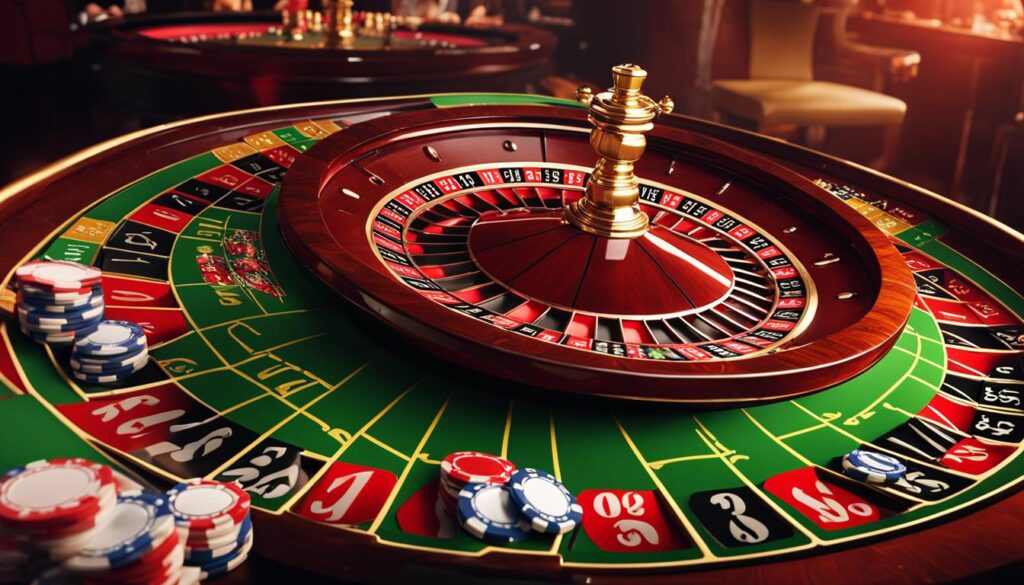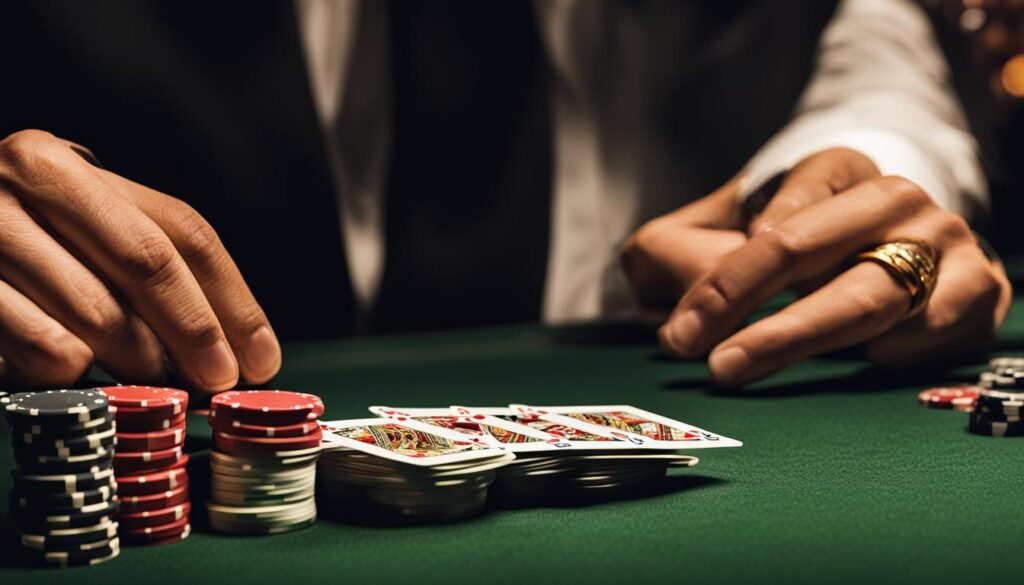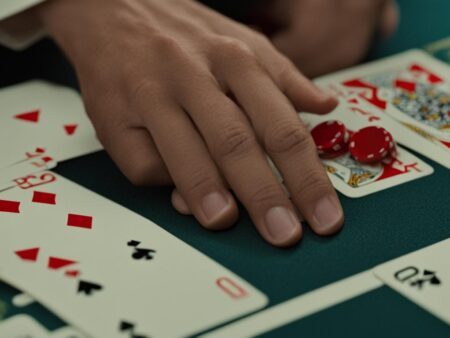There is a common misconception about whether blackjack and 21 are the same game. Let’s explore the truth behind this mystery and uncover the differences between the two.
Key Takeaways:
- Blackjack and 21 are similar card games, but they have distinct differences in rules and strategies.
- The dealer follows a specific strategy, hitting on 16 and staying on 17 or higher.
- The complexities of soft 16 and variations in casino rules can affect the dealer’s strategy.
- Successful players like Don Johnson have exploited casinos’ offers and discounts to tip the odds in their favor.
- Understanding the rules, strategies, and nuances of blackjack and 21 is crucial for both players and dealers to navigate the game effectively.
Understanding the Basics of Blackjack and 21
Blackjack and 21 are popular card games that involve strategic decision-making and a little bit of luck. While many people use the terms interchangeably, there are subtle differences between the two games. Let’s take a closer look at the basic rules and gameplay of blackjack and 21.
In both blackjack and 21, the objective is to have a hand that is worth 21 points or as close to 21 as possible without exceeding this value. The game is played between a player and a dealer, with the player aiming to outscore the dealer without going over 21.
The gameplay begins with the player receiving two cards. The player then has the option to “hit” and receive additional cards or “stay” and keep their current hand. The dealer also receives two cards, but with one card face down and another face up. The player’s goal is to make strategic decisions based on their own hand and the dealer’s visible card, trying to determine the best course of action to maximize their chances of winning.
Key Differences in Blackjack Rules and Strategies
While blackjack and 21 share similar objectives, there are important differences in their rules and strategies. In blackjack, players have the option to double down or split their hand under certain conditions, which can significantly impact the outcome of the game. These options are not available in the standard version of 21.
Additionally, blackjack typically utilizes multiple decks of cards, while 21 is often played with a single deck. The number of decks used can affect the odds and strategies employed by both players and dealers.
Understanding the distinctions between blackjack and 21 is crucial for players looking to enhance their gameplay and make informed decisions on whether to hit, stay, double down, or split their hand. By familiarizing themselves with the rules and strategies of both games, players can improve their chances of beating the dealer and coming out on top.
The Dealer’s Strategy in Blackjack
In blackjack, the dealer follows a specific strategy based on the rules of the game. Understanding the dealer’s strategy is key to maximizing your chances of winning. According to standard blackjack strategy, the dealer will hit when their hand is worth 16 or less and stay when their hand is worth 17 or higher.
By hitting on 16, the dealer aims to improve their hand and get closer to 21 without going over. This strategy is based on the assumption that there is a higher probability of drawing a card that will improve their hand, as opposed to busting (going over 21).
However, it’s important to note that the dealer’s strategy of hitting on 16 applies only to “hard” 16s, which are hands consisting of only two cards. If the dealer has a “soft” 16, which means one of the cards is an Ace, the strategy changes. In this case, the dealer should stay on soft 16 because the Ace can be counted as either 1 or 11, providing more flexibility and a better chance of winning.
The Complexities of Soft 16
When it comes to the game of blackjack, the strategy for dealers on a hand worth 16 is relatively straightforward – hit if it’s a hard 16 (consisting of two non-Ace cards), and stay if it’s a soft 16 (including an Ace). This rule is based on the fact that a hard 16 has a higher likelihood of busting, while a soft 16 offers more flexibility due to the Ace’s dual value of 1 or 11.
But what exactly makes a soft 16 different from a hard 16, and why does it affect the dealer’s strategy? Let’s dive deeper into the complexities of soft 16 and how it can impact the outcome of a blackjack game.
A soft 16 occurs when the dealer’s hand includes an Ace and another card with a value of 5. In this situation, the Ace can be counted as either a 1 or an 11, giving the dealer more options to improve their hand without going over 21. By choosing to stay on a soft 16, the dealer reduces the risk of busting and increases the chances of beating the player. This decision is crucial for the dealer, as it can significantly influence the outcome of the game.
| Dealer’s Hand | Best Decision |
|---|---|
| Ace + 5 | Stay |
| Ace + 2 + 3 | Hit |
| Ace + 4 + Q | Hit |
As shown in the table above, different combinations of cards can result in a soft 16 for the dealer. When the dealer has an Ace with a 5, the best decision is to stay. However, if the dealer’s hand consists of an Ace with a 2 and a 3, or an Ace with a 4 and a Queen, hitting is the optimal play. These decisions are based on statistical probabilities and the goal of maximizing the dealer’s chances of winning.
In conclusion, understanding the complexities of soft 16 is essential for both players and dealers in the game of blackjack. While the basic strategy for dealers dictates hitting on a hard 16 and staying on a soft 16, the specific decision can vary depending on the cards in the dealer’s hand. By mastering these nuances, players can make more informed decisions and increase their chances of success at the blackjack table.
References:
- https://www.blackjackapprenticeship.com/blackjack-strategy-charts/
- https://www.casinoveritas.com/magazine/content/Blackjack+Basic+Strategy?aid=45
Don Johnson’s Success Against Casinos
Don Johnson, a notable and highly skilled blackjack player, achieved extraordinary success in the world of gambling. In one memorable night, he managed to win nearly $6 million, causing substantial losses for Atlantic City’s Tropicana casino. Johnson’s remarkable triumph can be attributed to his exceptional card-playing skills, as well as his expertise in exploiting the casinos’ offers and discounts.
What set Johnson apart from other players was his ability to capitalize on the discounts and favorable playing conditions provided by the casinos. He took advantage of hand-shuffled six-deck shoes, which eliminated the advantage of card-counting systems. Additionally, he benefited from the option to split and double down on multiple hands, further tilting the odds in his favor.
“When you can get an edge, you have to maximize it, and if you can’t get an edge, then you have to get back to the house edge.” – Don Johnson
The casinos, desperate to reverse their declining revenues, offered Johnson a 20% discount on his losses. They also provided him with favorable playing conditions that significantly reduced the house edge. With these advantageous offers, Johnson essentially turned the game into a 50-50 proposition against the house, greatly diminishing his risk and increasing his chances of winning.
Don Johnson’s success against the casinos serves as a testament to the importance of strategic gameplay and the exploitation of favorable conditions. By understanding the rules, strategies, and nuances of blackjack, players can enhance their decision-making and increase their chances of coming out on top, just like Johnson did.
The Casinos’ Desperation and Offers

As the casinos faced declining revenue, they grew desperate to attract high-rolling players like Don Johnson. They were willing to go to great lengths to entice him, offering lucrative discounts and favorable playing conditions. Johnson took advantage of the casinos’ desperation to maximize his chances of winning.
The first offer made to Johnson was a 20% discount, a substantial reduction in the house edge. This discount significantly tipped the odds in Johnson’s favor, making the game almost a 50-50 proposition. With such favorable conditions, Johnson saw a golden opportunity to capitalize on the casino’s desperation.
But the discounts were not the only advantage Johnson had. The casinos also provided favorable playing conditions that further reduced the house edge. Hand-shuffled six-deck shoes and the option to split and double down on multiple hands gave Johnson an edge over the house. By strategically exploiting these offers and using his exceptional card-playing skills, Johnson was able to stack the odds in his favor and walk away with millions.
“The casinos’ desperation worked in my favor. With the discounts and favorable playing conditions, I was essentially playing an even game against the house. It was a once-in-a-lifetime opportunity,” Johnson said.
The casinos’ desperation to attract high-stakes players like Don Johnson highlights the fierce competition in the gambling industry. In their quest to stay afloat, they were willing to make substantial concessions to entice skilled players. While Johnson’s success story might be exceptional, it sheds light on the lengths casinos are willing to go to boost their revenue.
Finding the Balance: Risk and Reward for the Dealer

For the dealer in blackjack, deciding whether to hit or stay on 16 is a delicate balance between increasing the chances of winning and reducing the risk of going bust. While the dealer is more likely to hit on 16 due to the rules, it’s crucial to remember that the house always has an advantage. Regardless of whether the dealer hits or stays on 16, the house holds the upper hand.
Playing as the dealer requires a strategic approach that takes into account the probabilities and expected values of different outcomes. By following the standard blackjack strategy of hitting on 16 or less and staying on 17 or higher, the dealer maximizes their chances of beating the players. However, this strategy is not foolproof and is based on statistical probabilities.
It’s important to note that the dealer’s strategy is not influenced by the players’ decisions. The dealer must follow a set of predetermined rules, and their actions are not dependent on the players’ choices. This adds an element of predictability to the game, as players can anticipate the dealer’s moves and adjust their own strategies accordingly.
The Dealer’s Risk
While the dealer’s strategy aims to minimize the risk of going bust, there is still an inherent risk involved. The decision to hit or stay on 16 is based on the probability of improving the dealer’s hand without exceeding 21. By hitting on 16, the dealer exposes themselves to the possibility of drawing a high-value card and going bust. However, staying on 16 also carries the risk of having a weaker hand compared to the players, especially if they have a hand worth 17 or higher.
The dealer’s risk is further influenced by the players’ actions. If the players at the table are employing effective strategies and making optimal decisions, the dealer’s chances of winning decrease. Conversely, if the players make poor choices and deviate from basic blackjack strategy, the dealer’s risk may be reduced.
In summary, the dealer’s strategy in blackjack revolves around finding the right balance between increasing the chances of winning and minimizing the risk of going bust. While the house always has an advantage, strategic decision-making can help dealers maximize their success at the table. Understanding the probabilities and expected values of different outcomes is key to achieving this balance and navigating the complexities of the game.
Conclusion
In conclusion, the debate over whether blackjack and 21 are the same game has been decoded. While these card games share similarities, they also have distinct differences in rules and strategies. Understanding these nuances is key to navigating the game effectively and increasing the chances of winning.
For dealers, the strategy of hitting on 16 and staying on 17 or higher is a delicate balance between maximizing winning opportunities and minimizing the risk of going bust. However, variations in casino rules and the complexities of soft 16 can impact the dealer’s strategy, creating additional challenges.
Successful players like Don Johnson have demonstrated that expertise in exploiting casinos’ offers and discounts can tip the odds in their favor. By taking advantage of favorable playing conditions and strategic discounts, players can significantly reduce the house edge and increase their chances of success.
Ultimately, whether you’re a player or a dealer, familiarizing yourself with the rules, strategies, and nuances of blackjack and 21 is crucial. Armed with this knowledge, you can navigate the game with confidence and make informed decisions that give you the best chance of coming out on top.
FAQ
Are blackjack and 21 the same game?
No, while they are similar card games, there are differences in rules and strategies between blackjack and 21.
What are the basics of blackjack and 21?
Both games are played between a player and a dealer, with the objective of getting a hand worth 21 points or as close as possible without going over.
What is the dealer’s strategy in blackjack?
The dealer will hit on a hand worth 16 or less and stay on a hand worth 17 or higher, following a specific strategy.
What are the complexities of soft 16?
Soft 16 refers to a hand that includes an Ace, and the strategy for the dealer changes in this case.
How did Don Johnson succeed against casinos?
Don Johnson’s success can be attributed to his exceptional card-playing skills and his ability to exploit offers and discounts provided by casinos.
What offers did the casinos provide to Don Johnson?
The casinos offered Johnson discounts and favorable playing conditions, such as hand-shuffled six-deck shoes and the option to split and double down on multiple hands.
How does the dealer find the balance between risk and reward?
The dealer’s decision to hit or stay on 16 is a delicate balance between increasing their chances of winning and reducing the risk of going bust.
What is the conclusion?
The article concludes that while blackjack and 21 have similarities, understanding the rules, strategies, and nuances of each game is crucial for players and dealers to maximize their chances of winning.







